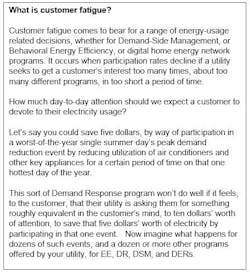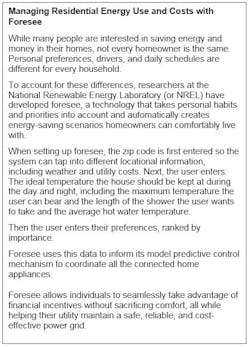Paco Underhill, the CEO of a company called Envirosell, Inc., which researches shopping in a scientific way, wrote a best-selling book titled Why We Buy, which includes an interesting finding about the significant increase in the amount of merchandise the average shopper buys in a department store or supermarket, when you provide customers with larger shopping carts.
Time is Money
What is the size of your utility’s proverbial customer engagement program “shopping cart?” How much attention would your residential customers have to devote to participate in all the different programs your utility offers them, if they were willing to say “yes” to as many of those programs as possible?
Minimizing the amount of time residential electricity customers have to spend making energy-related decisions, while maximizing their potential participation in energy-related programs, can provide great value for a wide range of smart utility programs.
A recently announced U.S. Department of Energy National Renewable Energy Laboratory (NREL) program is a great step forward in addressing customer fatigue. Customer fatigue is a problem for utilities seeking to optimize a range of customer engagement programs.
NREL Software Saves Energy, Costs, and More
Take a minute to program your smart thermostat. Simple enough, right? Now, set up multiple connected appliances so they all coordinate to reach a common goal. Not so easy, is it? In fact, at the moment it's nearly impossible.
"Right now, if you had a smart dishwasher, a smart washer/dryer, and a smart water heater, you'd have to set up the schedule for everything yourself," said Bethany Sparn, a mechanical engineer and researcher at the U.S. Department of Energy's (DOE's) National Renewable Energy Laboratory (NREL). "You'd have to think about how the appliances interact with each other, the occupants, the building, and the power grid. Deciding when you should turn on your lights seems reasonably intuitive, but how should you control your water heater to reduce your utility bill and use solar energy from your solar panels, without risking your hot shower?"
The solution could rest with NREL-developed software called "foresee," an energy management system that relies on user preferences to control and coordinate a home's connected appliances and electronics. The software first asks users to rank what's most important to them about living in their home. Then it takes those preferences into account and automatically adjusts the devices accordingly.
"Having automation that's built in, that has an understanding of what's required to keep people happy, is definitely not something that's on the market now," Sparn said.
Dane Christensen, leader of NREL's Residential Systems Performance team and principal investigator on the foresee project, said people typically identify four goals for their house: comfortable air temperature and hot water, convenience, reduced costs, and a low environmental impact. But the order and importance of these goals are different for every household.
"These four categories are hard to trade off against each other," Christensen said. "At foresee's core is a goal of running the home in a balanced way that best serves that family's unique values and schedule. Your goals are going to be different from my family's, just like a retiree on a fixed income is likely to have different goals than a millennial who just got her first job and is living large."
DER Plug & Play Challenge
A consortium of national labs and nonprofit organizations has announced a call for concepts to engage the smart grid community in demonstrating visionary interoperability capabilities on how facilities with distributed energy resources, or DERs, integrate and interact with the utility grid.
The Plug & Play DER Challenge is being organized and administered by Lawrence Berkeley National Laboratory (Berkeley Lab) for the U.S. Department of Energy’s Grid Modernization Laboratory Consortium (GMLC). The challenge is being rolled out in collaboration with DOE’s Pacific Northwest National Laboratory (PNNL), the Smart Electric Power Alliance (SEPA), the Electric Power Research Institute (EPRI), and the National Institute of Standards and Technology, alongside other project industry advisors.
“The future of local solar power and electric vehicle charging requires coordination with the flexibility in demand and storage to ensure a reliable and resilient electric grid,” said Steve Widergren, principal engineer at PNNL and interoperability project lead for the consortium. “Integration must be simplified across the board. This event challenges industry to leapfrog to a universal way that all these technologies can connect and operate in harmony with little fuss or bother.”
The Challenge Overview, with full details on timelines, specifications and requirements, can be found here.




